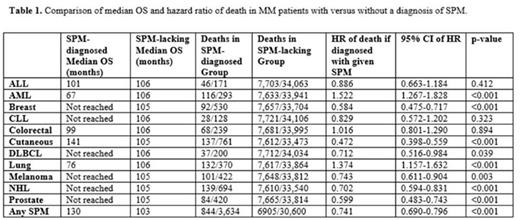Abstract
Background: While there is significant literature regarding the incidence of secondary primary malignancies (SPMs) in patients with multiple myeloma (MM), there is a relative paucity of data regarding prognosis and mortality in this population. This study aimed to utilize real-world data from the ASCO CancerLinq MM registry to determine outcomes of MM patients with SPMs.
Methods: CancerLinQ, backed by the American Society of Clinical Oncology (ASCO) and launched in 2014, is a cancer registry comprised of over 100 oncology practices and hospitals in the United States. For this retrospective analysis, we included MM patients who were diagnosed with MM between 2009 and 2021. ICD-9 and ICD-10 codes were utilized for SPM diagnoses of interest. Overall survival from the date of initial multiple myeloma diagnosis was the primary endpoint, and was compared between MM patients with versus without later diagnosis of a SPM. Analyses were conducted with STATA Version 17.0 (College Station, TX); critical alpha level was set at .05. Kaplan-Meier curves were generated to demonstrate overall survival (OS). Median OS and hazard ratios (HR) were calculated for all patients later diagnosed during the reporting period with a SPM versus without, and by specific SPMs versus all patients without that SPM.
Results: There were 34,234 patients meeting inclusion criteria, of whom 10.62% developed any SPM (n=3,634). Results showed longer median OS in all patients subsequently diagnosed with an SPM (130 months vs. 103 months, HR: 0.741, 95% CI 0.690-0.796, p<.001). Analyzed by specific SPM, median OS was prolonged in patients later diagnosed with non-melanoma cutaneous cancers compared to those without (141 months vs. 105 months, HR 0.472 p<.001; 95% CI 0.398-0.559), breast cancer (median OS not reached vs. 105 months, HR 0.584, 95% CI 0.475-0.717; p<.001), prostate cancer (median OS not reached vs 105 months, HR 0.599, 95% CI 0.483-0.743, p<.001), non-Hodgkin lymphoma (median OS not reached vs 105 months, HR 0.702, 95% CI 0.594-0.831, p<.001),diffuse large B cell lymphoma (median OS not reached vs. 106 months, HR .712, 95% CI .516-.984, p=.04), and melanoma (median OS not reached vs 105 months, HR 0.743, 95% CI 0.611-0.904, p=.003). Survival was not significantly affected in patients diagnosed with colorectal cancer, acute lymphoblastic leukemia, or chronic lymphocytic leukemia. Survival was worse in patients diagnosed with acute myeloid leukemia (67 months vs 106 months, HR 1.522, 95% CI 1.267-1.828, p<.001) and lung cancer (76 months vs 106 months, HR 1.374, 95% CI 1.157-1.632, p<.001).
Discussion: This is the first study to utilize a real-world dataset to characterize OS in MM patients subsequently diagnosed with an SPM. Counterintuitively, patients diagnosed with any SPM were more likely to have lived longer than patients not diagnosed with an SPM. This observation could be multifactorial and could reflect patients with more indolent disease biology or those who received better treatments, resulting in higher longevity and immortal time bias. Further study and results analyzing the timing of SPM diagnosis (post MM) and its subsequent impact on OS are forthcoming and will be presented. The finding that patients diagnosed with AML lived shorter likely is indicative of dramatically worse outcomes of secondary AML in the MM population. The shorter survival of patients diagnosed with lung cancer may also represent causal signal. The finding that both AML and lung cancer as SPMs resulted in shorter survival is consistent with what would be expected in the general population, and serves as a good internal control. In summary, this study is the first to shed light on prognosis of MM patients diagnosed with various SPMs.
Disclosure: The findings and opinions contained herein are those of the authors and do not represent the views/opinions of the United States Government, the United States Air Force, United States Navy, Walter Reed National Military Medical Center, or the Department of Defense.
Disclosures
Thornton:Douglas Lane & Associates: Other: NA - DL&A are an investment advisor registered with the SEC.
Author notes
Asterisk with author names denotes non-ASH members.


This feature is available to Subscribers Only
Sign In or Create an Account Close Modal